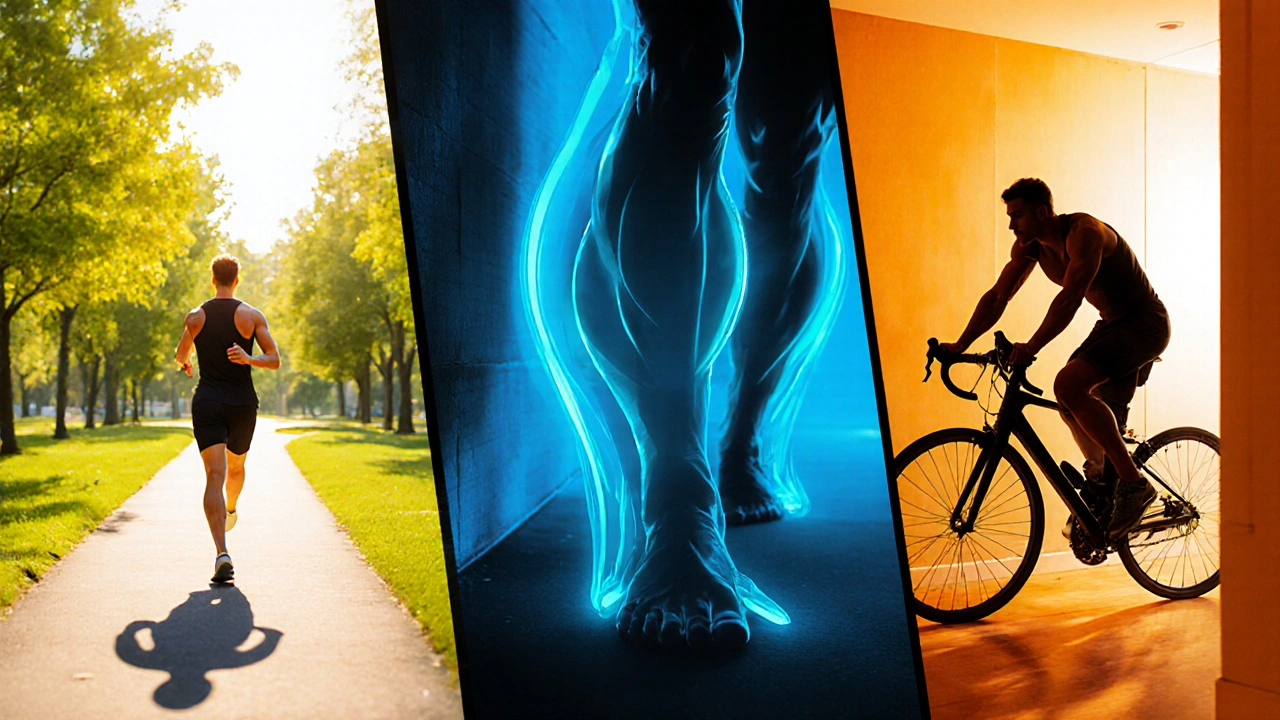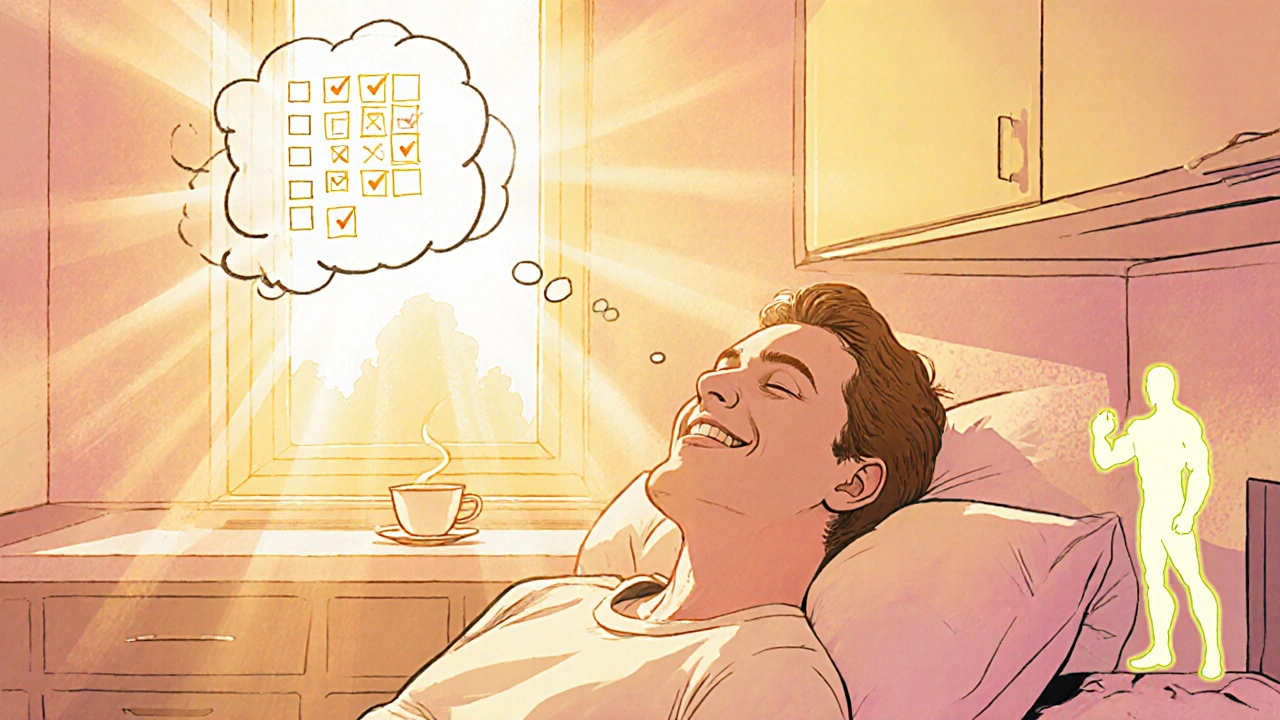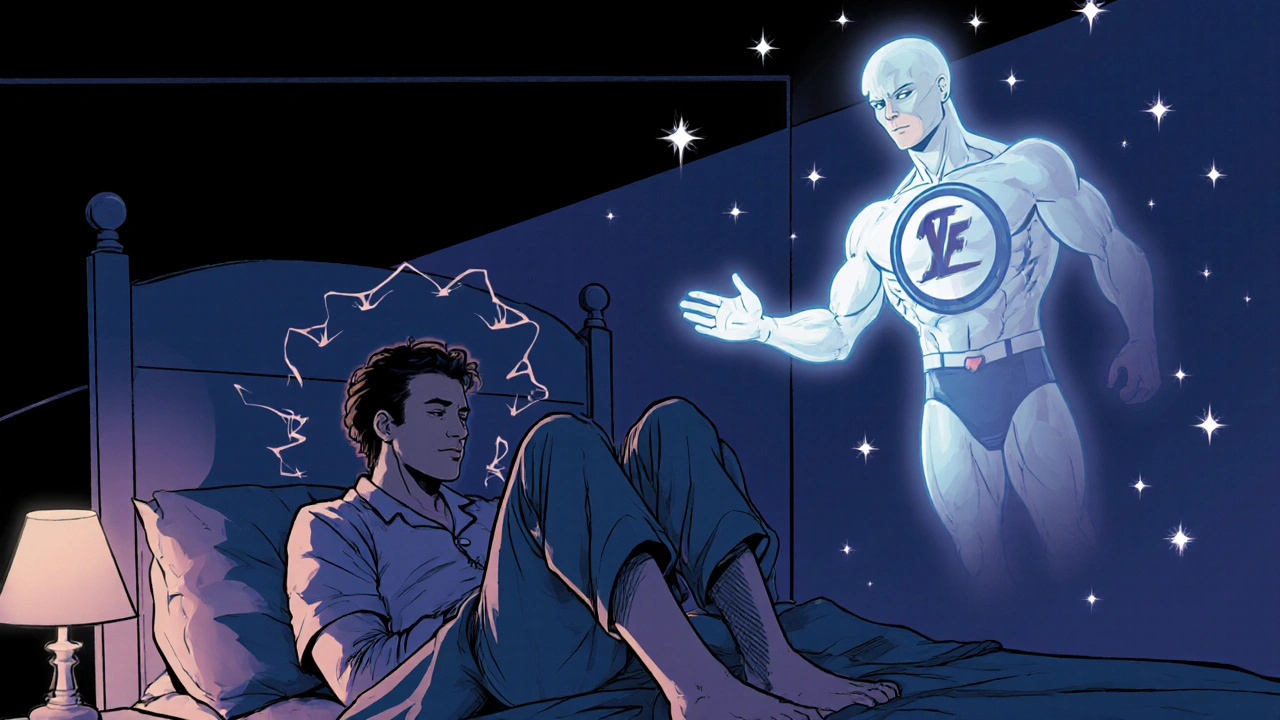RLS Exercise Planner
Calculate your ideal RLS-friendly exercise routine based on symptom severity. This tool suggests time allocations for each component of the recommended 20-minute daily plan.
Your Personalized Routine
Important: Total routine time will not exceed 20 minutes. For best results, maintain consistency and listen to your body.
Key Takeaways
- Regular physical activity can lower the frequency and intensity of RLS episodes.
- Aerobic cardio, gentle stretching, and light strength work are the most effective modalities.
- Start with short sessions, gradually increase duration, and listen to your body to avoid aggravating symptoms.
- Combining exercise with good sleep hygiene and iron‑rich nutrition maximises relief.
- A simple 20‑minute daily routine can make a noticeable difference within weeks.
If you’ve ever woken up with an uncontrollable urge to jiggle your legs, you know how frustrating restless leg syndrome can be. While medication and supplements get a lot of attention, many people overlook a low‑cost, side‑effect‑free tool that’s right at your fingertips: exercise. Below we’ll break down why moving your body helps, which activities work best, and how to weave them into a realistic daily plan.
Restless Leg Syndrome is a neurological condition characterized by uncomfortable sensations in the legs and an irresistible urge to move them, especially at rest or night time. The symptoms often disrupt sleep and can lead to daytime fatigue. Though the exact cause remains unclear, research points to dopamine dysregulation, iron deficiency, and impaired circulation as key contributors.
Exercise is any bodily activity that raises heart rate, uses muscle groups, and improves overall fitness. From brisk walking to gentle yoga, the body’s response to movement triggers biochemical changes that directly counteract several RLS mechanisms.
Why Exercise Works for RLS
Physical activity influences three main pathways that alleviate RLS symptoms:
- Dopamine regulation: Aerobic workouts boost dopamine production and receptor sensitivity, helping to calm the nervous system.
- Improved circulation: Moving the legs pumps blood, reducing the peripheral nerve irritation that often sparks tingling sensations.
- Iron metabolism: Regular exercise enhances iron absorption and utilization, addressing a frequent deficiency linked to RLS.
Studies from the American Academy of Neurology (2023) show that participants who added 150 minutes of moderate‑intensity cardio per week reported a 30% drop in nightly leg urges compared with a sedentary control group.

Top Exercise Types for RLS Relief
Not every workout delivers the same benefit. Here’s a quick look at the most RLS‑friendly options, ranked by effectiveness and ease of integration.
| Exercise | Typical Session | RLS Impact | Notes |
|---|---|---|---|
| Walking | 20‑30min brisk | High - improves circulation & dopamine | Can be done outdoors or on a treadmill |
| Stretching | 5‑10min targeted | Medium - reduces muscle tension | Focus on calves, hamstrings, quadriceps |
| Cycling (stationary) | 15‑20min low‑resistance | High - leg‑specific cardio | Keep resistance low to avoid over‑exertion |
| Yoga (gentle flow) | 20‑25min | Medium - combines stretch & mild cardio | Choose poses like Legs‑Up‑the‑Wall, Cat‑Cow |
| Strength training (bodyweight) | 10‑15min, 2‑3 sets | Low‑Medium - supports muscle health | Squats, lunges, calf raises; avoid heavy loads |
Aerobic activity like walking or cycling stands out as the top pick because it directly raises heart rate, mobilizes blood flow, and triggers dopamine release. Stretching complements cardio by loosening tight calf and shin muscles that often feel cramped during an RLS flare. Strength training isn’t a primary treatment but helps maintain muscle tone, which supports better circulation over the long term.
Designing a Simple RLS‑Friendly Routine
Here’s a 20‑minute daily plan that you can adjust as you get stronger:
- Warm‑up (3min): Light marching in place or a slow walk to get the blood moving.
- Cardio burst (7min): Brisk walk or stationary bike at a pace where you can talk but feel a slight breathlessness.
- Targeted stretching (5min):
- Calf stretch - place hands on a wall, step one foot back, press heel down for 30seconds each side.
- Hamstring stretch - sit on the floor, extend one leg, reach toward toes for 30seconds.
- Quadriceps stretch - standing, pull ankle toward glutes, hold 30seconds each side.
- Body‑weight strength (3min): Two sets of 10‑12 squats and calf raises, focusing on smooth motion.
- Cool‑down (2min): Gentle yoga pose “Legs‑Up‑the‑Wall” to promote venous return.
Start with this schedule three times a week. After two weeks, add a fourth session or extend each cardio burst by two minutes. Consistency beats intensity when it comes to managing RLS.

Safety Tips and Common Mistakes
Exercise is beneficial, but doing it wrong can worsen leg discomfort. Keep these pointers in mind:
- Don’t overheat: Excessive heat can trigger RLS sensations. Keep indoor workouts at a comfortable temperature (68‑70°F).
- Avoid high‑impact drills: Jumping or heavy running may inflame already sensitive nerves.
- Stay hydrated: Dehydration reduces blood volume, limiting circulation benefits.
- Listen to your legs: If a session leaves you with lingering cramps, reduce intensity next time.
- Check iron levels: If you notice little improvement after a month, a blood test for ferritin may be needed.
Quick RLS‑Exercise Checklist
- ✔️ Aim for 150min of moderate cardio per week.
- ✔️ Include a 5‑10min leg‑focused stretch after each session.
- ✔️ Add light strength moves twice weekly.
- ✔️ Keep a workout log to track symptom changes.
- ✔️ Review iron status and sleep hygiene alongside exercise.
Frequently Asked Questions
Can I do exercise if I experience severe RLS at night?
Yes, but keep the intensity low and focus on gentle movements like walking or yoga. High‑impact workouts close to bedtime may actually worsen nighttime urges.
How soon will I notice relief?
Most people report a measurable drop in leg urges after 2-4 weeks of consistent activity. Benefits keep building as fitness improves.
Is it safe to combine exercise with medication?
Generally, yes. Exercise doesn’t interfere with typical RLS drugs like gabapentin or dopamine agonists. However, discuss any new regimen with your doctor, especially if you’re on blood‑thinners.
What if I have joint pain that limits walking?
Low‑impact options such as stationary cycling, swimming, or seated leg extensions can still boost circulation without stressing joints.
Do I need a personal trainer?
Not necessarily. The routine above is designed for beginners. If you have other health conditions, a physical therapist can tailor movements to your needs.
Exercise isn’t a miracle cure, but it’s a proven, accessible strategy that tackles several root causes of restless leg syndrome. Pair a consistent movement plan with good sleep habits, iron‑rich foods, and medical guidance, and you’ll likely see fewer night‑time leg jitters and more restful mornings.

rachel mamuad
July 19, 2025
Yo folks, the neuro physio-kinetics behind RLS actually sync up with cardio-induced dopamne surge-so a simple walk can modulate the sensorimotor loop. Gotta keep the iron intake optimal, otherwise the microvascular flow is subpar. Also, low-impact HIIT (if you can call it that) can stim the basal ganglia without overtaxing the myofascial stuff. Try the 20‑min routine, tweak the cardio burst to your severity and monitor the nocturnal urge frequency. Consistency beats intensity, fam.
Amanda Anderson
July 23, 2025
I felt the leg jitters melt away after just one brisk walk!
Carys Jones
July 28, 2025
Let me be perfectly clear: the notion that a casual stroll magically cures restless leg syndrome is a seductive myth perpetuated by wellness marketers who love a good sell‑out story. While exercise undeniably has physiological benefits, reducing complex dopaminergic dysregulation to "just move your legs" is a gross oversimplification. The research cited in the article, though respectable, glosses over the heterogeneity of patient response-some people see a marginal drop in urges, others see no change at all. Moreover, the piece fails to acknowledge that many RLS sufferers also grapple with comorbidities like peripheral neuropathy, which can make certain movements downright painful. Ignoring these nuances does a disservice to readers seeking honest guidance.
Another glaring omission is the absence of a discussion about medication interactions. For those on dopamine agonists, an aggressive cardio regimen might exacerbate side effects such as orthostatic hypotension. Similarly, overly intense strength training could elevate systemic inflammation, potentially worsening symptoms. The article’s blanket recommendation of “moderate cardio” without qualifiers is irresponsible.
Let’s not forget the socioeconomic context. Suggesting a daily 20‑minute routine assumes access to safe walking environments or a stationary bike, resources that are not universally available. This implicit class bias renders the advice elitist, sidelining patients in crowded urban apartments or rural areas without gyms.
Finally, the tone of the article borders on paternalistic, implying that if you don’t adhere to the suggested plan, you’re somehow failing to take care of yourself. Such moralizing language can induce guilt, which is counterproductive for a condition already linked to anxiety and insomnia. A balanced, empathetic approach would acknowledge limitations, encourage individualized adjustments, and stress the importance of consulting a healthcare professional before overhauling one’s routine.
Roxanne Porter
July 31, 2025
Thank you for raising those important considerations. I agree that a one‑size‑fits‑all prescription can overlook individual health variables and access issues. Patients should indeed discuss any new exercise regimen with their physician, especially when medications are involved. Tailoring intensity, duration, and modality to personal circumstances is essential for safety and efficacy. Your points help round out the discussion.
Jonathan Mbulakey
August 4, 2025
Exercise, in many ways, mirrors the philosophical quest for equilibrium: we constantly balance effort and ease, pushing boundaries while listening to subtle signals from the body. When we engage in a modest walk, we are not merely burning calories; we are recalibrating the neurochemical orchestra that governs movement and sensation. This perspective can shift how we view RLS-not as a curse, but as an invitation to explore mindful motion.
Warren Neufeld
August 6, 2025
I hear you, Jonathan, and I think the analogy is spot on. Adding a brief, intentional routine can act like a daily meditation, gradually easing the nervous system into a more stable rhythm. It’s a gentle reminder that small, consistent actions often outweigh occasional bursts of intensity.
Deborah Escobedo
August 9, 2025
Stick with the 20‑minute plan and track how your symptoms change week by week. Small adjustments, like extending the cardio segment by a minute as you get stronger, can make a big difference over time.
Dipankar Kumar Mitra
August 11, 2025
Oh, come on, Deborah, you’re selling a cookie‑cutter fantasy. Real life isn’t a 20‑minute Instagram reel; it’s a chaotic mess where stress, diet, and genetics collide. If you want genuine relief, stop glossing over the messy truth and start demanding personalized protocols, not generic playlists.
Tracy Daniels
August 13, 2025
Let’s make sure everyone feels included in the conversation 😊. For those who can’t walk outside, consider seated leg extensions or water aerobics; both offer cardiovascular benefits without the need for a treadmill. And always keep a hydration bottle handy-the brain and muscles perform best when well‑hydrated.
Hoyt Dawes
August 16, 2025
Really? That’s the best you can propose? It’s amateurish and lacks any nuanced insight.